Canthium inerme
Canthium inerme (L.f.) Kuntze
Family: Rubiaceae
Common names: turkey-berry; common turkey-berry; criss-cross turkey-berry; Cape date (Eng.); gewone bokdrol; doringels (Afr.); umvuthwamini (Xhosa, Zulu); umnyushulube (Xhosa); isitobe (Zulu); mvutwamira (Sw); mmutswa-o-sepela (Northern Sotho); muvhibvela-shadani (Venda)
SA Tree No: 708
Introduction
The ecological and cultural aspects of this tree, its lovely aesthetic qualities and its relatively widespread distribution in southern Africa, make this species perhaps the best known Canthium in the region.

Description
Description
Owing to the wide range of habitats in which it occurs and the diverse environmental conditions associated with this, the species exhibits much variability in terms of growth form and size. Under forest conditions, where strong competition for light necessitates upward-reaching growth, heights of up to 14 m may be attained. In contrast, those in more exposed conditions grow notably shorter in height, commonly between 3 m and 7 m, and assume a more spreading habit and rounded crown. Trees may be single or multistemmed, with main stems achieving diameters of up to 360 mm.

When young, the stems are smooth and pale grey, becoming rougher and darker with age, and forest specimens often exhibit impressive twisted and fluted stems with rough, flaking bark. The smooth, light-coloured stems are a very attractive feature of the species, allowing the tree to stand out visually against its surrounds.
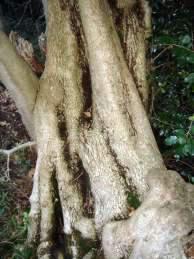
The branches are borne in opposite pairs with each pair at right angles to the next, this being a very distinctive character of the species and indeed other members of the genus also.Branches, and sucker shoots in particular, are often armed with strong, stout spines up to 70 or 80 mm long, produced just above the nodes in opposite pairs. Leafy spine-like branches are occasionally encountered.
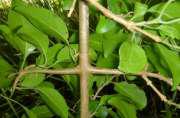
The leaves are a lovely ornamental feature and are light green, glossy and hairless with a soft, leathery texture. They are simple and opposite, are elliptic in shape and range from 25-100 x 10-45 mm. The leaf margins, which are entire (untoothed) and often undulate, are slightly rolled under and domatia (small pockets), often containing hairs, are present in the axils of the veins on the leaf undersurface. The petioles (leaf stalks) are up to 15 mm long, between which stipules up to 4 mm in length are produced, these interpetiolar stipules being characteristic of the family as a whole.
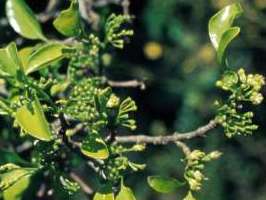
Cream-coloured to green-yellow flowers are produced from August to February. They are small in size and usually in dense axillary clusters up to 30 mm across.
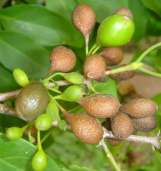
The 2-lobed, 2-seeded, oval-shaped fruits are produced from October to April. They are glossy green when young but, in ripening, become dark brown and wrinkled and may remain on the tree for many months.
As far as canthiums are concerned, this species is not likely to be confused with others in the genus with the exception perhaps of C. suberosum which it superficially resembles. The latter however lacks spines or spine-like branchlets and young branches are somewhat powdery becoming noticeably corky on older stems, unlike in C. inerme. C. suberosum is also less extensive in its distribution.
Conservation Status
Status
Canthium inerme is not threatened.
Distribution and habitat
Distribution description
Canthium inerme is a relatively common species with a wide distribution range in southern Africa. Palmer & Pitman (1972) note this range as extending from the Cape Peninsula in the Western Cape, into Eastern Cape, through KwaZulu-Natal, Swaziland, Mpumalanga, and Limpopo, Mozambique and Zimbabwe. It is found in a variety of habitats from coastal and montane forest, dune forest and forest margins, to bushveld and rocky grasslands. The altitudinal range is quite impressive, stretching from coastal areas to around 1 700 m above sea level. According to Von Breitenbach (1965), the species is frequent in coastal scrub and drier forest types, becoming less so in the medium-moist forests and near absent from the moist and wet forests. It is not a species of very arid conditions.
Derivation of name and historical aspects
History
The plant family to which the Canthium genus belongs is the renowned and much-admired gardenia family, the Rubiaceae. The Rubiaceae holds the distinction of being the largest family of trees in southern Africa comprising roughly 160 indigenous to the region. It is among the world's largest families of flowering plants with approximately 637 genera and some 10 700 species, most strongly represented in the tropics but cosmopolitan on the whole (Allaby 1998).
Most members of the Rubiaceae, which include herbs, shrubs, trees and climbers, share some common features which quickly indicate their belonging to the family, namely leaves which are opposite and entire with interpetiolar stipules. Much taxonomic work however still remains to be done on the family. It is probably most famous, not only for its numerous horticulturally valuable members, which include the all-popular genera Gardenia, Ixora, Pavetta, Pentas and Rothmannia, but for quinine, from the South American Cinchona species, and coffee, mainly Coffea arabica and C. canephora. The extent of the latter's fame is apparent when one considers that it is the world's second largest revenue generator for a natural product after petroleum (Van Wyk & Van Wyk 1997).
The Canthium genus is comprised of trees and shrubs totalling roughly 50 species, occurring in Africa, the Indian Ocean islands and Asia. Of these, around 15 species in southern Africa are listed as trees, these being concentrated mainly in the eastern parts of the region.

The generic name Canthium is derived from the word canti, the Malabar (Indian) name for a member of this genus (Palmer & Pitman 1972). The specific epithet inerme is intriguing as it literally means unarmed or without spines. This is not always the case, however, as spines are clearly evident on some specimens.
As for the vernacular names, the English name turkey-berry is believed to refer to the fact that turkeys take a particular liking to the fruit. The very descriptive bokdrol, Afrikaans for antelope droppings, is reference to the resemblance of these to the fallen fruit, and is also fitting.
Ecology
Ecology
The common turkey-berry clearly is a species with much ecological value and interest. A large proportion of the trees are known to bear fruit annually, although some not so regularly. Pollination is effected by bees in search of pollen and nectar, and self-pollination is also seen to take place (Von Breitenbach 1965). In commenting on other ecological aspects of this species, Von Breitenbach (1965) states that 'Fruits mature and fall after 3-4 months, and are eaten and dispersed by various birds and wild pigs. The larger proportion of the fruit crop falls prematurely. Many seeds are destroyed by doves and wild pigs, and by Dipterous larvae'.
Birds indeed play an important role in seed dispersal, carrying seed from the plant to often distant and scattered localities. Success in germination at these new localities is determined largely by the environmental conditions present as well as seed viability. In addition, the fruits are eaten by people and the tree serves as one of the host plants of the Natal Barred Blue butterfly (Spindasis natalensis). With regard to disease, species of Capnodium attack and prove fatal to some seedlings, while a species of leaf mould (Meliola woodiana) is known to attack more mature plants (Von Breitenbach 1965).
Uses
Use
Canthium inerme, like so many tree species in southern Africa, is utilized for medicinal purposes, the leaves being used in the treatment of stomach ailments (Coates Palgrave 2002) As mentioned previously, the fruits are eaten by people. The tree has been much used as shelter for stock, while the wood, which is hard, heavy and tough, is handsome and has been used in wagon-making and for furniture (Palmer & Pitman 1972). The species, with its horticultural potential becoming increasingly recognized, is now commonly encountered in the South African nursery trade.
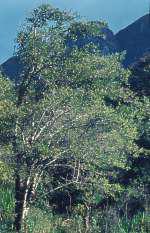
Growing Canthium inerme
Grow
Canthium inerme is relatively easy in terms of propagation and is best grown from seed. Seeds should be collected when ripe and cleaning of these is recommended prior to sowing. Sowing can be done in trays or seed beds in a rich, well-drained medium, with equal parts of sand and compost.Place in a warm, brightly-lit area and keep moist but not wet. Germination times may vary, depending on the time of year, from under a month to up to 2-3 months and growth is rapid once germinated. Following germination, allow the seedlings at least 2-3 weeks of growth before transplanting into bags or other suitable containers for further growing.
It is a beautiful and charming tree and greatly recommended for the garden setting where its low-growing and compact habit makes it ideal where space is slightly limited. Its evergreen nature ensures that its attractive foliage is present throughout the year and its presence is bound to attract numerous fruit-eating and insectivorous birds. The thorns, though stout and strong and worthy of respect, are generally not as menacing as some gardeners are led to believe and in fact give the tree a lovely visual quality. Plant in a large hole with plenty of compost and ensure watering is carried out until established. It is fairly hardy and because of its ability to tolerate a range of conditions, can be used in a variety of garden habitats to great effect
References
- Coates Palgrave, M. 2002. Keith Coates Palgrave Trees of southern Africa, edn 3. Struik, Cape Town.
- Lotter, M., McCleland, W. & Schmidt, E. 2002. Trees and shrubs of Mpumalanga and Kruger National Park. Jacana, Johannesburg.
- Palmer, E. 1977. A field guide to the trees of southern Africa. Collins, London.
- Palmer, E. & Pitman, N. 1972. Trees of southern Africa, 3 vols. Balkema, Cape Town.
- Pooley, E. 1993. The complete field guide to trees of Natal, Zululand and Transkei. Natal Flora Publications Trust, Durban.
- Tilney, P. 2003. Canthium, Keetia and Psydrax (Rubiaceae) in South Africa, Part 2 : how to recognize the South African species of Canthium. Plantlife 28: 19-25.
- Van Wyk, B. & Van Wyk, P. 1997. Field guide to trees of southern Africa. Struik, Cape Town.
- Von Breitenbach, F. 1965. The indigenous trees of southern Africa. Department of Forestry, Pretoria.
Credits
Jan-Hakon Burring
Kirstenbosch National Botanical Garden
July 2004
Plant Attributes:
Plant Type: Tree
SA Distribution: Eastern Cape, Gauteng, KwaZulu-Natal, Limpopo, Mpumalanga, North West, Western Cape
Soil type: Sandy, Clay, Loam
Flowering season: Early Summer
PH: Acid, Alkaline, Neutral
Flower colour: Green, Cream, Yellow
Aspect: Full Sun, Shade, Morning Sun (Semi Shade), Afternoon Sun (Semi Shade)
Gardening skill: Easy
Special Features:
Horticultural zones










Rate this article
Article well written and informative
Rate this plant
Is this an interesting plant?
Login to add your Comment
Back to topNot registered yet? Click here to register.